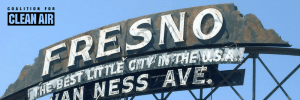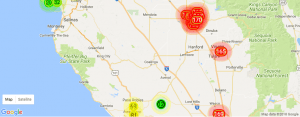1. Check the Outdoor Air Quality
The air in many parts of our state has been at extremely hazardous levels for weeks. When this happens, it is unsafe for all populations to spend time outside. People with heart or lung diseases, children, and older adults should take extra precautions.
For the past three years, CCA has worked tirelessly to bring our CLEAR (Community Learning Enhances Air Resources) air quality monitoring network to as many schools, homes and offices as possible, to empower Californians with the knowledge of the level of air pollution they are exposed to on a consistent basis. We also want to welcome our new CLEAR Program Manager Victor Polanco, who can be reached at victor@ccair.org.
In the absence of having your own monitor installed, keep checking the map on our website and take any and all of the measures listed below.
“Since I’ve received my CLEAR monitor, I’ve had no asthma
attacks or illnesses, since I can see if air quality outside my
house is dangerous to me. Thank you Coalition for Clean Air
for the opportunity to participate. It’s been a lifesaver,
to say the least. “
– Janet Dietzkamei, Asthma sufferer, San Joaquin Valley
2. Stay Indoors, but if you must go outside, protect yourself.
Do not exert yourself outside when pollution levels are high. Keep children inside as much as possible. Air pollution at these levels has been shown to affect developing immune systems in young people and cause older people to be less able to resist infections like flu or pneumonia. High PM2.5 can also trigger heart attack and stroke in susceptible individuals.
A cotton handkerchief will block approximately 30% of the particles. A surgical mask will block approximately 80%. The best masks are the N95 masks used by painters and landscapers which block 98-99% of particles.
3. If you have an HVAC system, check and potentially replace your air filter.
Air filters run the scale from MERV 1-18. The higher the MERV, the smaller the particles it can capture. If you want to capture the very fine particulates that are most damaging to our health, you’ll need MERV 11-16. However, the higher the MERV, the harder it is for your furnace to pull air through the filter. For older, weaker HVAC systems, you’ll have to find the right balance. See a description of MERV ratings here.
4. Check and Potentially Replace Your Car’s Air Filter
To protect your car or truck’s cabin air, you should replace its filter regularly. The location and recommended filter type can be found in the owner’s manual or online. Most filters are available at auto parts stores or through your mechanic.
5. Invest in an Air Purifier for Your Home
Portable air cleaners may be moved from room to room and used when continuous and localized air cleaning is needed.
A few things to keep in mind:
HEPA is the best for PM2.5 (Winter-time pollution): Any filter that is of HEPA quality will capture the fine particles. Pay attention to how the product defines HEPA; “HEPA Type” is not true HEPA. Filters must be changed regularly to maintain their effectiveness.
Activated Carbon is Good for Ozone (Summer-time pollution): Filters with an activated carbon layer can remove 60-70% of ozone pollution in the home.
Avoid “ionizers,” they can create ozone: Ionizers change the electromagnetic charge of particles so the filtration unit can more easily capture the pollution, which unfortunately also leads to the creation of Ozone. Ozone can irritate airways and exacerbate breathing-related problems.
Avoid or turn off UV Lights: Most UV light cleaners are ozone-free and will not damage lungs, but they do not kill pathogens as well as they say they do, if at all.
Learn more about air filtration devices here.
6. Avoid Smoking Anything
Not burning is the single greatest thing you can do to protect the air and your own and your neighbors’ health. For example one in five people in the San Joaquin Valley have asthma and one in four have high blood pressure. Your smoke could trigger an asthma attack or stroke in someone on your street! At the very least, some of your neighbors will not be able to walk outside or even leave their home if you’re burning.
Your lungs were not made to breathe anything but clean air. Give them a break.
Thank you to our friends at Central Valley Air Quality Coalition and CCA San Joaquin Valley consultant Genevieve Gale for permission to share a portion of the content of this blog.
[share title=”Share This Post”]









